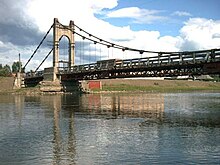Ust-Kataw
| city
Ust-Kataw
Усть-Катав
|
||||||||||||||||||||||||||||||||||||||||||
|
||||||||||||||||||||||||||||||||||||||||||
|
||||||||||||||||||||||||||||||||||||||||||
| List of cities in Russia | ||||||||||||||||||||||||||||||||||||||||||
Ust-Kataw ( Russian Усть-Катав ) is a Russian city with 23,580 inhabitants (as of October 14, 2010) in the central Urals , in the Chelyabinsk Oblast .
description
The city is about halfway between the metropolises of Ufa on this side and Chelyabinsk on the other side of the Urals, on the European side of the continental border. The city was founded in 1758. Ust-Kataw consists of an old town in a valley around the Kataw reservoir , three newer districts, called Mikrorajon 1 to Mikrorajon 3 , and a few suburbs, former villages.
Ust-Kataw is not rich in outstanding architecture. The old town, surrounded by mountains and forests of the Urals, has a picturesque effect , especially on the lakeshore, while the three newer microrajons covered by a ridge were built in the less appealing Soviet prefabricated building style. In Ust-Katav the river flows Katav in the larger Yuryuzan , a tributary of the Ufa .
history
The city was founded in 1758 as part of the local iron ore mining, as the confluence of the Kataw and Jurjusan rivers offered a good opportunity. In the beginning, the settlement consisted of a mill, a sawmill and a little later a steelworks. Local iron production gained international importance in the 19th century and was presented at the London Industrial Exhibition in 1862. A parish also came into being during this period, which existed until 1920 in the early Soviet era and was revived in the new Russia. In 1889 the place was connected to the Russian railway network.
In 1917 a local workers 'and soldiers' council took power in the village. In 1939, 13,000 people lived here. During the Second World War, the city's importance as a place of industrial production increased and in the post-war period the production of trams began, which was to make Ust-Kataw known throughout Russia. During the Soviet era, apart from the LM types and RWS types (best known RWS-6) produced in and for Leningrad from Riga (Rishskij wagonostroitjelnyj zavod), by far the largest number of trams in the country were manufactured here, over 13,000 KTM-5s alone. In addition, parts of rocket engines for Russian space travel were produced. The House of Culture was built in 1952, and in 1979 the new residential district of the Mikrorajons, where the majority of the population lives today. In 1980 the dam was built, which decisively shaped the current character of the place (creation of today's reservoir).
Population development
| year | Residents |
|---|---|
| 1939 | 13,032 |
| 1959 | 23,133 |
| 1970 | 23,438 |
| 1979 | 24,521 |
| 1989 | 31,218 |
| 2002 | 25,898 |
| 2010 | 23,580 |
Note: census data
Economy and Transport
Ust-Kataw plays an important role in the construction of trams throughout Russia, and the Kirov wagon factory there was the only tram manufacturer in the country for many years. Rocket parts for the Russian aerospace industry and the military are also produced industrially in the city. In agriculture, animal husbandry (especially cows and goats) and the cultivation of wheat and sunflowers in the city and the surrounding area play a major role.
Ust-Kataw is not far from the M5 trunk road , one of the most important Russian east-west axes, which leads from Moscow via Samara , Ufa and Chelyabinsk to the Siberian metropolises of Omsk and Novosibirsk . The main railway line from Moscow via Samara in the direction of Siberia also runs through the city's train station, which is also often used by long-distance trains for a stopover or exchange of locomotives when crossing the Urals. Local public transport only consists of a few bus lines, a tram line that has existed since 1973 is only used for testing the railways built in the city, but until 1995 it also had public service.
Education and culture
There is a technical faculty of the University of Chelyabinsk in the city . Otherwise there is a polytechnic and a vocational school. As in most other small Russian towns, the cultural offerings are not dense: apart from two cinemas, there is only the “culture house” and a ballet school, which are compulsory in Russia .
Sports
The Ust-Kataw boxing team is the city's flagship club and has at times achieved international importance. There is also an ice hockey team that plays in a regional league and a football club. There is an indoor swimming pool in a sports complex. Despite the corresponding slopes and snow conditions in the area, skiing is only practiced by the local residents, as there is no relevant infrastructure in the immediate vicinity of the city.
sons and daughters of the town
- Oļegs Znaroks (* 1963), Latvian ice hockey player
Individual evidence
- ↑ a b Itogi Vserossijskoj perepisi naselenija 2010 goda. Tom 1. Čislennostʹ i razmeščenie naselenija (Results of the All-Russian Census 2010. Volume 1. Number and distribution of the population). Tables 5 , pp. 12-209; 11 , pp. 312–979 (download from the website of the Federal Service for State Statistics of the Russian Federation)




